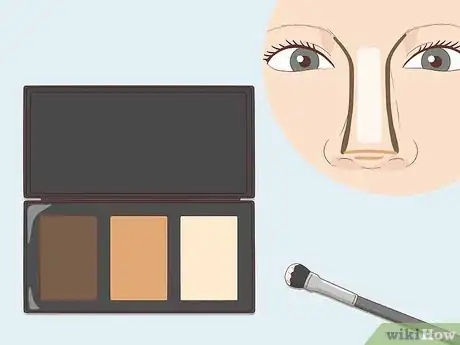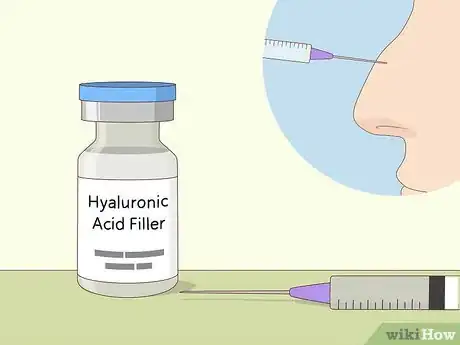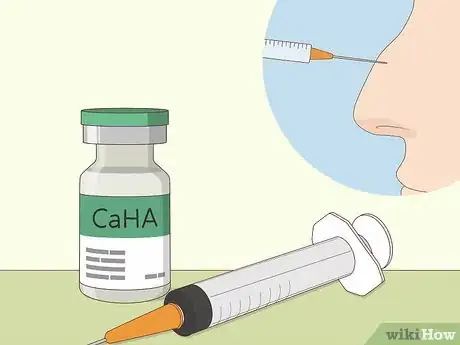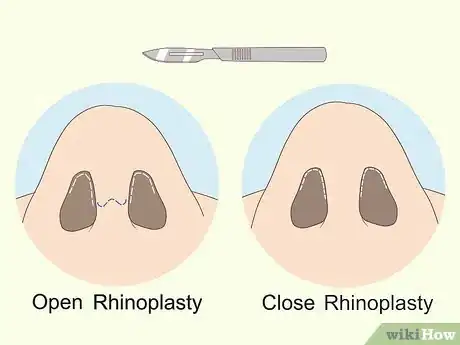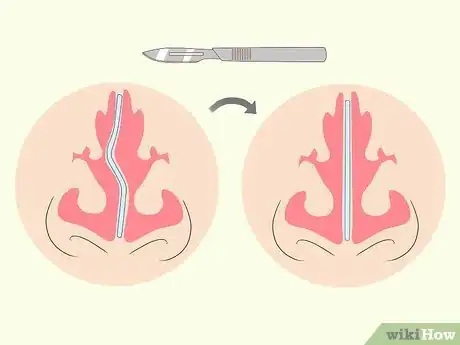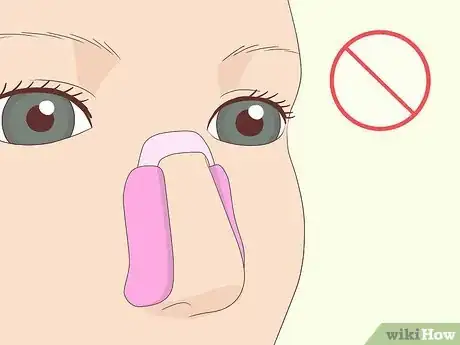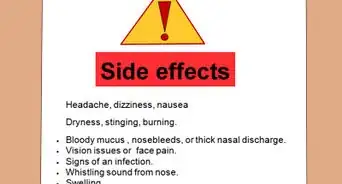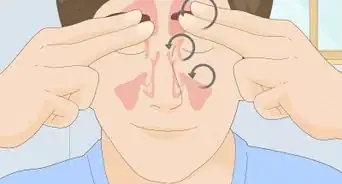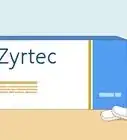This article was co-authored by Marc Kayem, MD and by wikiHow staff writer, Amber Crain. Dr. Marc Kayem is a board certified Otolaryngologist and Facial Plastic Surgeon based in Beverly Hills, California. He practices and specializes in cosmetic services and sleep-related disorders. He received his Doctorate in Medicine from the University of Ottawa, is board certified by the American Board of Otolaryngology, and is a Fellow of the Royal College of Surgeons of Canada.
There are 14 references cited in this article, which can be found at the bottom of the page.
This article has been viewed 190,032 times.
Crooked noses aren't uncommon, but if yours really bothers you, it's understandable that you'd want to fix it. We've researched your options and uncovered lots of useful tips to help you out. We’ll start with a simple contouring makeup trick so you can disguise your nose temporarily. Then, we'll touch on longer-lasting fixes and procedures, like dermal fillers and plastic surgery options, so you can explore all of the possible options.
Here are 7 different ways you can straighten a crooked nose.
Steps
Expert Q&A
Did you know you can get premium answers for this article?
Unlock premium answers by supporting wikiHow
-
QuestionCan I keep taking my medications before a surgery?
 Marc Kayem, MDDr. Marc Kayem is a board certified Otolaryngologist and Facial Plastic Surgeon based in Beverly Hills, California. He practices and specializes in cosmetic services and sleep-related disorders. He received his Doctorate in Medicine from the University of Ottawa, is board certified by the American Board of Otolaryngology, and is a Fellow of the Royal College of Surgeons of Canada.
Marc Kayem, MDDr. Marc Kayem is a board certified Otolaryngologist and Facial Plastic Surgeon based in Beverly Hills, California. He practices and specializes in cosmetic services and sleep-related disorders. He received his Doctorate in Medicine from the University of Ottawa, is board certified by the American Board of Otolaryngology, and is a Fellow of the Royal College of Surgeons of Canada.
Plastic Surgeon It depends on the surgery and the medications, so talk to your doctor and the surgeon to see what you can take in the weeks leading up to the surgery. For most surgeries, you want to stop blood thinners, aspirin, vitamin E, fish oil, any homeopathic medication at least 2 weeks before the surgery. Tylenol is typically the only thing you can take within 2 weeks of a surgery, but it depends on the procedure and your personal situation.
It depends on the surgery and the medications, so talk to your doctor and the surgeon to see what you can take in the weeks leading up to the surgery. For most surgeries, you want to stop blood thinners, aspirin, vitamin E, fish oil, any homeopathic medication at least 2 weeks before the surgery. Tylenol is typically the only thing you can take within 2 weeks of a surgery, but it depends on the procedure and your personal situation. -
QuestionI had a septorhinoplasty over a year ago and I'm not satisfied with the rhinoplasty results. I'd like to do a revision. Is this safe?
 Chris M. Matsko, MDDr. Chris M. Matsko is a retired physician based in Pittsburgh, Pennsylvania. With over 25 years of medical research experience, Dr. Matsko was awarded the Pittsburgh Cornell University Leadership Award for Excellence. He holds a BS in Nutritional Science from Cornell University and an MD from the Temple University School of Medicine in 2007. Dr. Matsko earned a Research Writing Certification from the American Medical Writers Association (AMWA) in 2016 and a Medical Writing & Editing Certification from the University of Chicago in 2017.
Chris M. Matsko, MDDr. Chris M. Matsko is a retired physician based in Pittsburgh, Pennsylvania. With over 25 years of medical research experience, Dr. Matsko was awarded the Pittsburgh Cornell University Leadership Award for Excellence. He holds a BS in Nutritional Science from Cornell University and an MD from the Temple University School of Medicine in 2007. Dr. Matsko earned a Research Writing Certification from the American Medical Writers Association (AMWA) in 2016 and a Medical Writing & Editing Certification from the University of Chicago in 2017.
Family Medicine Physician
References
- ↑ https://www.youtube.com/watch?v=JUVE8-r2vHU&t=233s
- ↑ https://www.ncbi.nlm.nih.gov/pmc/articles/PMC6484576/
- ↑ https://www.plasticsurgery.org/news/blog/what-is-liquid-rhinoplasty
- ↑ https://www.americanboardcosmeticsurgery.org/procedure-learning-center/non-surgical/injectable-fillers-guide/
- ↑ https://www.plasticsurgery.org/cosmetic-procedures/dermal-fillers/cost
- ↑ https://www.americanboardcosmeticsurgery.org/procedure-learning-center/non-surgical/injectable-fillers-guide/
- ↑ https://pubmed.ncbi.nlm.nih.gov/17372068/
- ↑ https://www.americanboardcosmeticsurgery.org/procedure-learning-center/face/rhinoplasty-guide/
- ↑ Marc Kayem, MD. Sleep Specialist. Expert Interview. 24 October 2020.
- ↑ https://www.mayoclinic.org/tests-procedures/rhinoplasty/about/pac-20384532
- ↑ https://www.plasticsurgery.org/cosmetic-procedures/rhinoplasty/cost
- ↑ https://www.plasticsurgery.org/reconstructive-procedures/septoplasty
- ↑ https://www.mayoclinic.org/tests-procedures/septoplasty/about/pac-20384670
- ↑ https://www.health.harvard.edu/blog/can-facial-exercises-reverse-the-signs-of-aging-2019022016042
- ↑ https://www.wired.com/story/nose-face-shapers-social-media/
- ↑ Marc Kayem, MD. Sleep Specialist. Expert Interview. 24 October 2020.
About This Article
To fix your crooked nose, consider injection rhinoplasty or plastic surgery. Injection rhinoplasty is a quick and easy procedure where a plastic surgeon injects dermal filler into your nose to make it look straighter. Surgical procedures are done under local or general anesthetic and involve a plastic surgeon re-sculpting the shape of your nose. If you don't want to get a procedure done, there are a few easy ways you can make your nose appear straighter with makeup. All you'll need is 3 different shades of contouring makeup. One should be 2 shades darker than your natural skin tone, one should be slightly darker than your natural skin tone, and the other should be 2 shades lighter than your skin tone. First, draw 2 straight lines down the sides of your nose with the darkest shade of makeup. Then, draw lines outside those dark lines with the medium shade of contouring makeup. Apply the lightest shade to the bridge of your nose. The combination of these shades will create the illusion of a straighter nose. For more tips from our Medical co-author, including how to work out if your crooked nose is causing you medical problems, read on.
